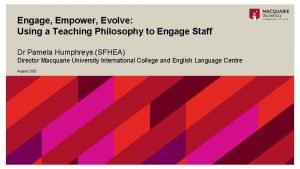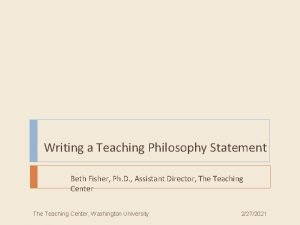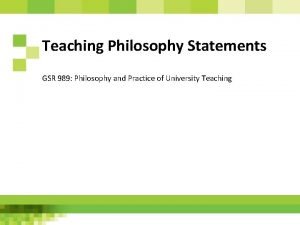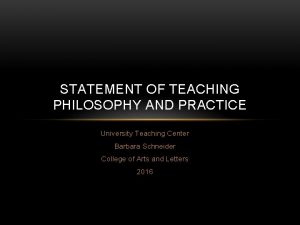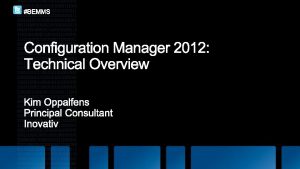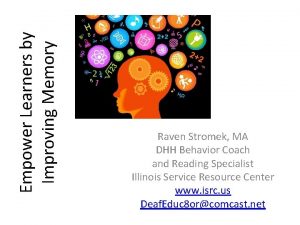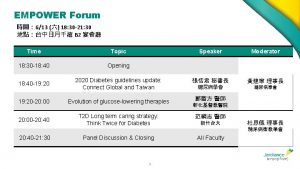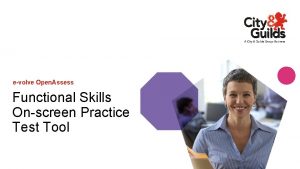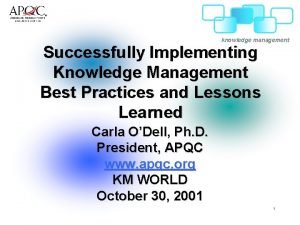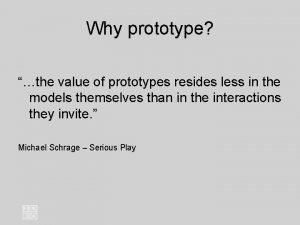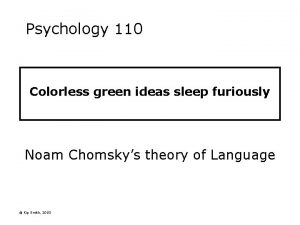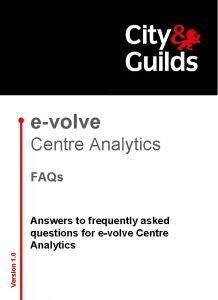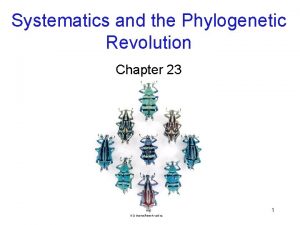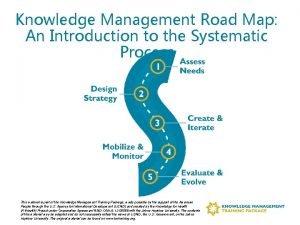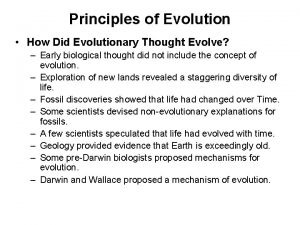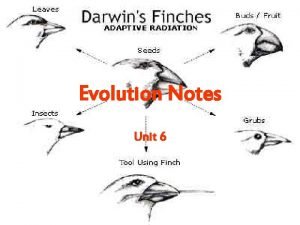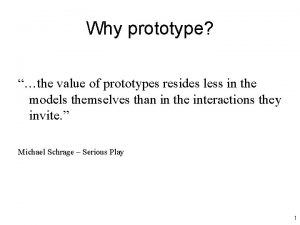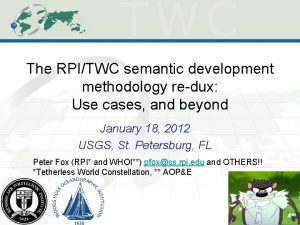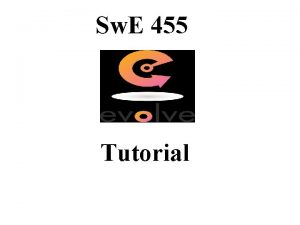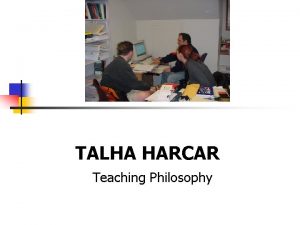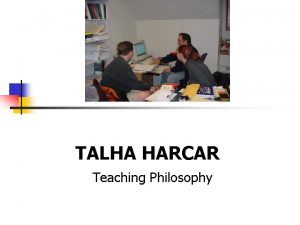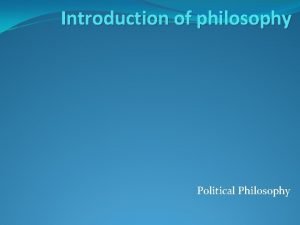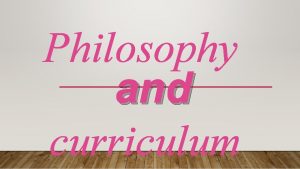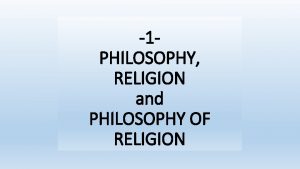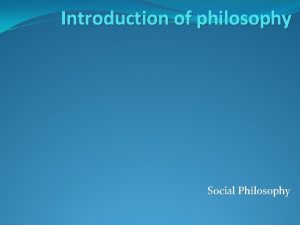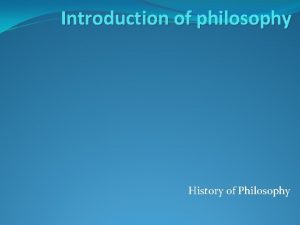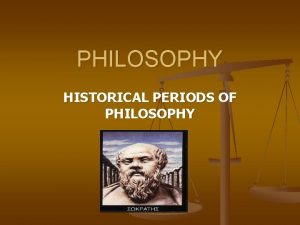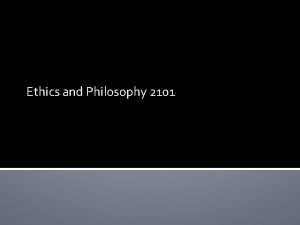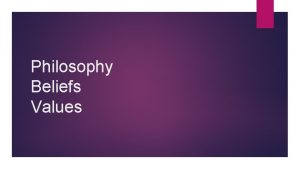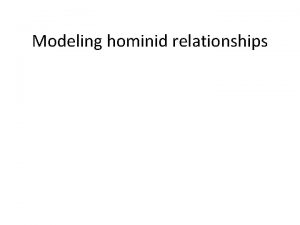Engage Empower Evolve Using a Teaching Philosophy to








































- Slides: 40

Engage, Empower, Evolve: Using a Teaching Philosophy to Engage Staff Dr Pamela Humphreys (SFHEA) Director Macquarie University International College and English Language Centre August 2020

Overview

Overview Part 1: Developing an individual TP Part 2: Developing an institutional TP What is a Teaching Philosophy? Why write a TP? How do you write a TP? Our approach Outcomes and further institutional use Conclusion: lessons learnt MUIC-ELC 3

Part 1 Developing an Individual Teaching Philosophy

Part 1 WHAT IS A TEACHING PHILOSOPHY (TP)? 5

Part 1 WHAT IS A TEACHING PHILOSOPHY (TP)? A TP is a statement of: • your beliefs about teaching and learning • your learners’ goals, and • how you operationalise your beliefs It is typically: • quite short (1 -2 pages) • written in the first person • sincere, honest, reflective, specific, avoiding clichés and platitudes • grounded in theory Consider: • the audience • the intended purpose 6

Richard Millwood Learning Theories Map http: //hotel-project. eu/sites/default/files/hotel/default/content-files/documentation/Learning-Theory. pdf OFFICE | FACULTY | DEPARTMENT 7

Part 1 WHY WRITE A TEACHING PHILOSOPHY? SUMMATIVE REASONS FORMATIVE REASONS 8

Part 1 WHY WRITE A TEACHING PHILOSOPHY? SUMMATIVE REASONS • • • Job application Interview PDR/annual review Assessment task (pre-service; qualification) Component of a Continuing Professional Development portfolio e. g. English Australia CPD framework Teaching award applications e. g. HEA fellowship (Advance HE) 9

Part 1 WHY WRITE A TEACHING PHILOSOPHY? FORMATIVE PURPOSES Individual TP can • articulate implicit and espoused beliefs • connect theory to practice • focus early career teachers • engage ‘seasoned’ professionals • show professional growth and change (longitudinal) • be used as a springboard to an institutional philosophy Institutional TP can • provide shared nomenclature • provide shared direction and identity in “doing something that matters” (Cranston & Keller, 2013) • improve ownership, agency, accountability • aid PD planning • be used as a springboard for other uses 10

Part 1 HOW DO YOU WRITE A TEACHING PHILOSOPHY? CHISM 1998 11

Part 1 HOW DO YOU WRITE A TEACHING PHILOSOPHY? CHISM 1998 1. 2. 3. 4. 5. Conceptualisations of learning: How do you think your students learn? Conceptualisations of teaching: What do you think your role is in this process? Your goals for your students: What do you think your students should learn; to what level? How you make it happen: This is the implementation. Do you practise what you preach? Your action plan: This also includes your professional development agenda. 12

Part 1 HOW DO YOU WRITE A TEACHING PHILOSOPHY? SENTENCE STEMS 1. 2. 3. 4. 5. As a teacher, I believe (that my students learn by)…. My role as a teacher is to… My students need to be able to…and therefore should learn… In my classes, I do x, y, z because…/ in order to… I need to/am going to develop/work on/find out more about… 13

Part 1 HOW DO YOU WRITE A TEACHING PHILOSOPHY? CHAPPELL 2017 1. Articulating (documenting and questioning our stance) 2. Interrogating (comparing theoretical and philosophical orientations) 3. Implementing (making decisions that may lead to change) 14

Part 1 HOW DO YOU WRITE A TEACHING PHILOSOPHY? EXAMPLE OF SENTENCE STEMS I believe…. . 15

16

Part 1 HOW DO YOU WRITE A TEACHING PHILOSOPHY? METAPHORS 17

OFFICE | FACULTY | DEPARTMENT 18

19

Over to you What’s your TP?

Part 2 Developing an institutional philosophy

Part 2 WHY WRITE AN INSTITUTIONAL TP? 22

Part 2 WHY WRITE AN INSTITUTIONAL TP? • • • In contexts with high casual staff, a sense of community/shared identify can be low. An organizational teaching philosophy might be helpful for creating a shared identify (similar to values or mission statements). Co-constructing such statements with staff improves ownership; agency, sense of community. A shared teaching philosophy might improve shared approach as an institution. It provides shared nomenclature. 23

Part 2 HOW DO YOU WRITE AN INSTITUTIONAL TP? OFFICE | FACULTY | DEPARTMENT 24

Blogging, posting and commenting on the Wiki 25

26

OFFICE | FACULTY | DEPARTMENT 27

Blogging and posting on the Wiki 28

Teaching and Learning Philosophy ENGAGE EMPOWER EVOLVE We Engage students in active learning and critical reflection via our focused delivery model. STUDY We Empower students to SKILLS become independent learners capable of adapting to new environments. CAREERS We Evolve through best AND practice in learning and teaching. EMPLOYME NT 29

30

Mini Festival of Learning and Teaching 53 STAFF MEMBERS 4 PARALLEL STREAMS 31

DEVELOPMENT OF A Teaching and Learning Strategy 2019 -2020 32

Teaching Excellence Framework 7 STANDARDS AT 4 PERFORMANCE LEVELS 33

Teaching Excellence Framework 7 STANDARDS AT 4 PERFORMANCE LEVELS Based on i) university teaching criteria and ii) the Australian professional standards for teachers 34

Conclusion: Lessons learnt

Conclusion Positives Developing a TP • built team rapport • provided shared nomenclature • provided shared direction • got traction with staff • positively impacted curriculum design • positively impacted PD • legitimised other work • underpinned other institutional activities MUIC-ELC 36

Conclusion: lessons learnt Positives Developing a TP • built team rapport • provided shared nomenclature • provided shared direction • got traction with staff • positively impacted curriculum design • positively impacted PD • legitimised other work • underpinned other institutional activities MUIC-ELC Lessons learnt We should • decide if TP is to be student-facing or staff-facing • involve teachers early in the process • remember that the process is as important as the product 37

Over to you Would an institutional TP work for you?

Publication Humphreys, P. (2020). Engage, empower, evolve: Developing an institutional teaching philosophy for engage staff. English Australia Journal, 36(1), pp. 39 -53). 39

References Alexander, P. , Chabot, K. , Cox, M. , De. Voss, D. , Gerber, B. , Perryman-Clark, S. , Platt, J. , Johnson Sackey, D. , & Wendt, M. (2012). Teaching with technology: Remediating the teaching philosophy statement. Computers and Composition, 29, 23 -38. doi: 10. 1016/j. compcom. 2011. 12. 002 Barnard, R. , & Burns, A. (Eds. ). (2012). Researching language teacher cognition and practice: International case studies. New York: Multilingual Matters. Basturkmen, H. (2012). Review of research into the correspondence between language teachers’ stated beliefs and practices. System, 40(2), 282 -295. Beatty, J. , Leigh, J. , & Dean, K. L. (2009). Finding our roots: Exercise for creating a personal philosophy statement. Journal of Management of Education, 33(1), 115 -130. Borg, S. (2006). Teacher cognition and language education: Research and practice. London: Continuum. Borg, S. (2012). Current approaches to language teacher cognition research: A methodological analysis. In R. Barnard & A. Burns (Eds. ), Researching language teacher cognition and practice, pp. 11 -29. Bristol: Multilingual Matters. British Association of Lecturers in English for Academic Purposes (BALEAP). (2019). Individuals: Information about the BALEAP TEAP fellowship scheme for EAP professionals. Retrieved from https: //www. baleap. org/accreditation/individuals Caukin, N. , & Brinthaupt, T. (2017). Using a teaching philosophy statement as a professional development tool for teacher candidates. International Journal for the Scholarship of Teaching and Learning, 11 (2), Article 18. https: //doi. org/10. 20429/ ijsotl. 2017. 110218 Chappell, P. (2017). Interrogating your wisdom of practice to improve classroom practices. ELT Journal, 71(4), 433 -444. https: //doi. org/10. 1093/elt/ccx 004 Chappell P. , Bodis, A. , & Jackson, H. (2015). The impact of teacher cognition and classroom practices on IELTS test preparation courses in the Australian ELICOS sector. IELTS Research Report Series 6. Retrieved from https: //www. ielts. org/teaching-and-research/research-reports/online-series-2015 -6. Chism, N. V. N. (1998). Developing a philosophy of teaching statement. Essays on Teaching Excellence, 9(3), 1 -2. Cooperrider, D. L. & Whitney, D. (2001). A positive revolution in change. In Cooperrider, D. L. , Sorenson, P. , Whitney, D. , & Yeager, T. (Eds. ), Appreciative inquiry: An emerging direction for organization development, pp. 9 -29. Champaign, IL: Stipes. Coppola, B. (2002). Writing a statement of teaching philosophy. Journal of College Science Teaching, 31(7), 448 -453. Retrieved from http: //emp. byui. edu/firestonel/ bio 405/readings/Teaching%20 Philosophy. pdf Cranston, S. , & Keller, S. (2013). Increasing the ‘meaning quotient’ of work. Mc. Kinsey & Company. Retrieved from https: //www. mckinsey. com/business-functions/ organization/our-insights/increasing-themeaning-quotient-of-work English Australia. (2019). English Australia CPD Framework. https: //www. englishaustralia. com. au/professional-development/cpd-framework Freire, P. (1970). Pedagogy of the oppressed. New York: Continuum. Goodyear, G. E. & Allchin, D. (1998). Statement of teaching philosophy. To Improve the Academy, 17, 103 -22. Higher Education Academy. (2018). Australia. Advance HE. Retrieved from: https: //www. heacademy. ac. uk/nation/australia Hutchings, P. , & Shulman, L. S. (1999). The scholarship of teaching: New elaborations, new developments. Change, 3(5), 10 -15. Mantai, L. (2018). Punk-rock inspired teaching philosophy. Retrieved from https: //teche. mq. edu. au/2018/04/punk-rock-inspired-teaching-philosophy/ Montell, G. (2003 a, March 27). How to write a statement of teaching philosophy. Chronicle of Higher Education. Retrieved from http: //chronicle. com/jobs/2003/03/2003032702 c. htm. Montell, G. (2003 b, March 27). What’s your philosophy on teaching, and does it matter? Chronicle of Higher Education. Retrieved from http: //chronicle. com/jobs/2003/03/2003032701 c. htm. Pajares, M. F. (1992). Teachers’ beliefs and educational research: Cleaning up a messy construct. Review of Educational Research, 62(3), 307 -333. Ramsden, P. (2003). Learning to teach in higher education. Oxford: Routledge Falmer. Schonwetter, D. J. , Sokal, L. , Friesen, M. & Taylor, K. L. (2002). Teaching philosophies reconsidered: A conceptual model for the development and evaluation of teaching philosophy statements. The International Journal for Academic Development, 7(1), 83 -97. Shohamy, E. (2001). The power of tests. Oxford: Routledge. Shulman L. S. (2004). The wisdom of practice: Essays on teaching, learning, and learning to teach. San Francisco, CA: Jossey-Bass. Trigwell, K. , Martin, E. , Benjamin, J. , & Prosser, M. (2000). Scholarship 40
 Educate empower evolve
Educate empower evolve Philosophy of education
Philosophy of education Theodore brameld philosophy of education
Theodore brameld philosophy of education Sample philosophy of teaching
Sample philosophy of teaching Realism philosophers
Realism philosophers Teaching philosophy examples
Teaching philosophy examples Western electric rules
Western electric rules Teaching philosophy examples
Teaching philosophy examples Ppmds
Ppmds Empower tapping
Empower tapping Inform educate and empower public health
Inform educate and empower public health Digital india power to empower
Digital india power to empower Empower users
Empower users Empower every person and every organization
Empower every person and every organization Inspire vs empower
Inspire vs empower Empower custom fields validation
Empower custom fields validation Poe empower
Poe empower Empower human resources
Empower human resources Inspire vs empower
Inspire vs empower Empower labs
Empower labs 賴史明醫師
賴史明醫師 Empower 3 custom fields
Empower 3 custom fields Etweb empower
Etweb empower Analogous structures
Analogous structures Prosimii
Prosimii Open assess city and guilds
Open assess city and guilds Apqc
Apqc Evolve knowledge
Evolve knowledge Explore evolve validate prototype
Explore evolve validate prototype Eveek
Eveek Overgeneralization
Overgeneralization City & guilds evolve
City & guilds evolve Most complex characters evolve
Most complex characters evolve Evolve knowledge
Evolve knowledge Evolve berlinist
Evolve berlinist Gene pool
Gene pool History of evolutionary thought
History of evolutionary thought Evolve
Evolve Explore evolve validate prototype
Explore evolve validate prototype Evolve
Evolve Evolve knowledge
Evolve knowledge
